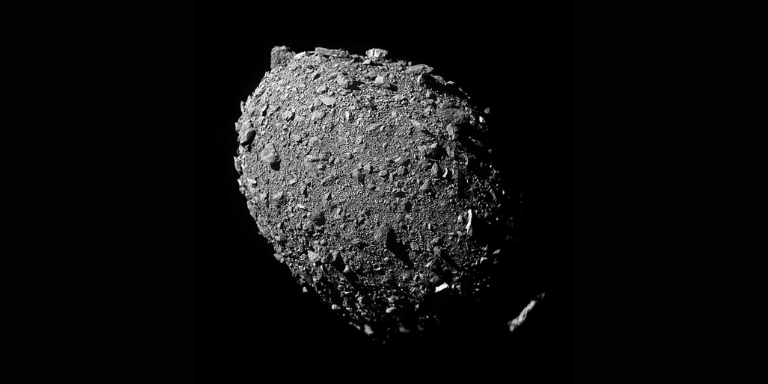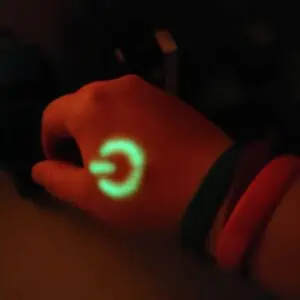Whenever the name “Dimorphos” comes, its elder brother “Didymos” is also come heard. These are like twin brothers and these twin brother makes their own system called the binary asteroid system.
Table of Contents
Toggle
The asteroid Didymos and its small moonlet Dimorphos together make up the binary asteroid system.
The small moon or minor-planet moon Dimorphos orbits the larger asteroid Didymos as like Earth and Moon.

Discovery of Didymos and Dimorphos asteroid
In Greek “Didymos” means “twin”. It was discovered on April 11, 1996, by researcher Joseph Montani of Spacewatch at Kitt Peak National Observatory in Tucson, Arizona.
Joseph Montani suggested the name “Didymos” the first time and according to him, it was named.
The cause behind his suggestion for this name is- the scientists have recorded multiple echoes in data from NASA’s Goldstone Solar System Radar, located in the Mojave Desert near Barstow, California.
They thought that this asteroid might have a moon.
Further, the suspicions were confirmed by analyzing the optical light curves along with radar images from the Arecibo Observatory in Puerto Rico taken on Nov. 23, 2003.
It has a diameter is 170 meters (560 feet) and however, the Didymos has 780 meters (2,560 feet) across.
Rubble Pile Structure of Dimorphos asteroid
This asteroid is characterized as a rubble pile.
In astronomy, a rubble pile is a low-density astronomical object or celestial body consisting of numerous pieces of rock which have strongly amalgamated due to the influence of gravity.
The pictures from the last five minutes of the DART mission clearly show the structure and shape of the asteroid as an egg-shaped body covered with boulders.
These clearly indicate the rubble pile structure of the Dimorphos asteroid.
The final few minutes of pictures from the DART mission revealed an egg-shaped body covered with boulders, clearly indicating it has a rubble pile structure.
You May Also Read: James Webb Telescope image revealed the hidden mysteries
Double Asteroid Redirection Test (DART) mission
Although these two asteroids are not a threat to Earth, just because they pass close proximity to earth, they were selected as the target object for NASA’s Double Asteroid Redirection Test (DART) mission.
The DART mission is the first mission of NASA to test planetary defense technology.
In near future, this technology could be used to protect Earth by deflecting hazardous asteroids before they collide with Earth.
The DART mission of NASA launched to Didymos at 1:21 a.m. EST on Nov. 24, 2021, on a SpaceX Falcon 9 rocket from Vandenberg Air Force Base in California.

On Sept. 26, 2022, at 7:14 p.m. EDT, the DART intercepted the smaller moonlet asteroid at a speed of about 4 miles or 6.6 kilometers per second.
During this time of DART’s impact, the position of Dimorphos was about 6.8 million miles (11 million kilometers) from Earth.

The main goal of the mission is to determine the impact of DART’s impact on the Dimorphos asteroid. How much has the velocity of the moonlet altered?
This can be predicted by measuring the change in the orbit of Dimorphos’s around the Didymos.
It has been predicted that the impact should alter the orbital period of the moonlet around the larger asteroid Didymos by several minutes.
This change can be observed and measured from Earth by using ground telescopes.
An international campaign coordinated by Northern Arizona University’s Cristina Thomas (DART’s Observations Working Group Lead) is using powerful Earth-based telescopes to study the asteroid system now that DART has hit its target.
You May Also Read: Wildcat Ridge rock samples of Mars hints presence of ancient life on Mars
According to NASA, the close views, as well as the live image of the Dimorphos asteroid, were possible before impact due to the onboard DRACO instrument.
The DRACO stands for Didymos Reconnaissance and Asteroid Camera for Optical navigation, the high-resolution imager.
It helped DART to navigate to the Didymos system before impact.
The DART had also shoebox-sized, small spacecraft, contributed by the Italian Space Agency (ASI). Its LICIACube – Light Italian CubeSat for Imaging of Asteroids.
It split apart from the DART several days before the DART’S impact with the moonlet Dimorphos asteroid.
Before that, the DART tested the Autonomous Navigation System Using the brightest stars in Earth’s night sky- Jupiter and Europa.
After capturing their images, the DART camera set its sights on another eye-catching spectacle: Jupiter and its four largest moons, and autonomously managed its navigation.
The LICIACube captured images of the impact and material (ejecta) kicked up from the moonlet during that time.

The European Space Agency plans to launch the Hera spacecraft to Dimorphos in 2024 to study the impact crater and the new orbit of the binary system.
What is Hera space mission?
Hera is a space mission, comes under the Space Safety program of the European Space Agency, and is in a development state.
Its primary objective is to validation of the kinetic impact method to deviate a near-Earth asteroid in a colliding trajectory with Earth.
It will be used to measure the size and morphology of the crater created after impact and the amount of momentum transferred by an artificial projectile during and after impacting an asteroid like Dimorphos.
This will help to measure the efficiency of the deflection produced by the impact.
The spacecraft is planned to lunch in October 2024. Obviously, it will also study the results of DART impactor.
It is expected that Hera will fully characterize for the first time- the composition and physical properties of the Didymos and Dimorphos asteroid binary stem from the external surface to internal structures.
Follow us on Facebook.
You May Also Read:
- Never seen “Cosmic Cliff” and Star Formation
- Alice electric plane- the first all-electric passenger airplane prepares to fly
- Purple Tomatoes! Journey from Molecular Lab to Modular Kitchen
- Space Pens or Pencils: How NASA Takes Notes in Space?
FAQ related to Dimorphos asteroid
Is Dimorphos a threat to Earth?
Dimorphos asteroid is a small moonlet of Didymos binary system and is not a threat to Earth.
How far is asteroid Dimorphos?
As Dimorphos is a part of Didymos binary system, it orbits the Didymos, and was located about seven million miles from Earth.
How heavy is Dimorphos asteroid?
The weight of the moonlet Dimorphos asteroid is about 11-billion-pound.
How far away is Dimorphos from Earth?
During the time of DART’s impact, Dimorphos was located about 11 million kilometers (6.8 million miles) from Earth.
When did Didymos hit Earth?
The Didymos and Dimorphos are small asteroids, and they are not threat to Earth. Neither Didymos nor Dimorphos ever hit the Earth.
The large binary asteroid Didymos and its moonlet Dimorphos currently pose no threat to Earth.
What is a DART mission?
DART mission stands for Double Asteroid Redirection Test (DART) mission. This is the first-ever mission dedicated for the investigation and demonstration of asteroid deflection by changing the motion of an asteroid in space through kinetic impact.
Why Dimorphos asteroid was chosen for the DART mission?
In the future, if there are any hazardous asteroids come toward Earth, their path should be deflected for the safety of Earth before they collide with Earth. Therefore, NASA planned to test with the DART mission and wants to change an asteroid’s orbit in preparation for future safety.
How fast will DART hit the Dimorphos asteroid?
The box-shaped DART spacecraft crushed the Dimorphos with a velocity of around 14,000 miles (22,530 kilometers) per hour to slightly slow its orbital speed.















